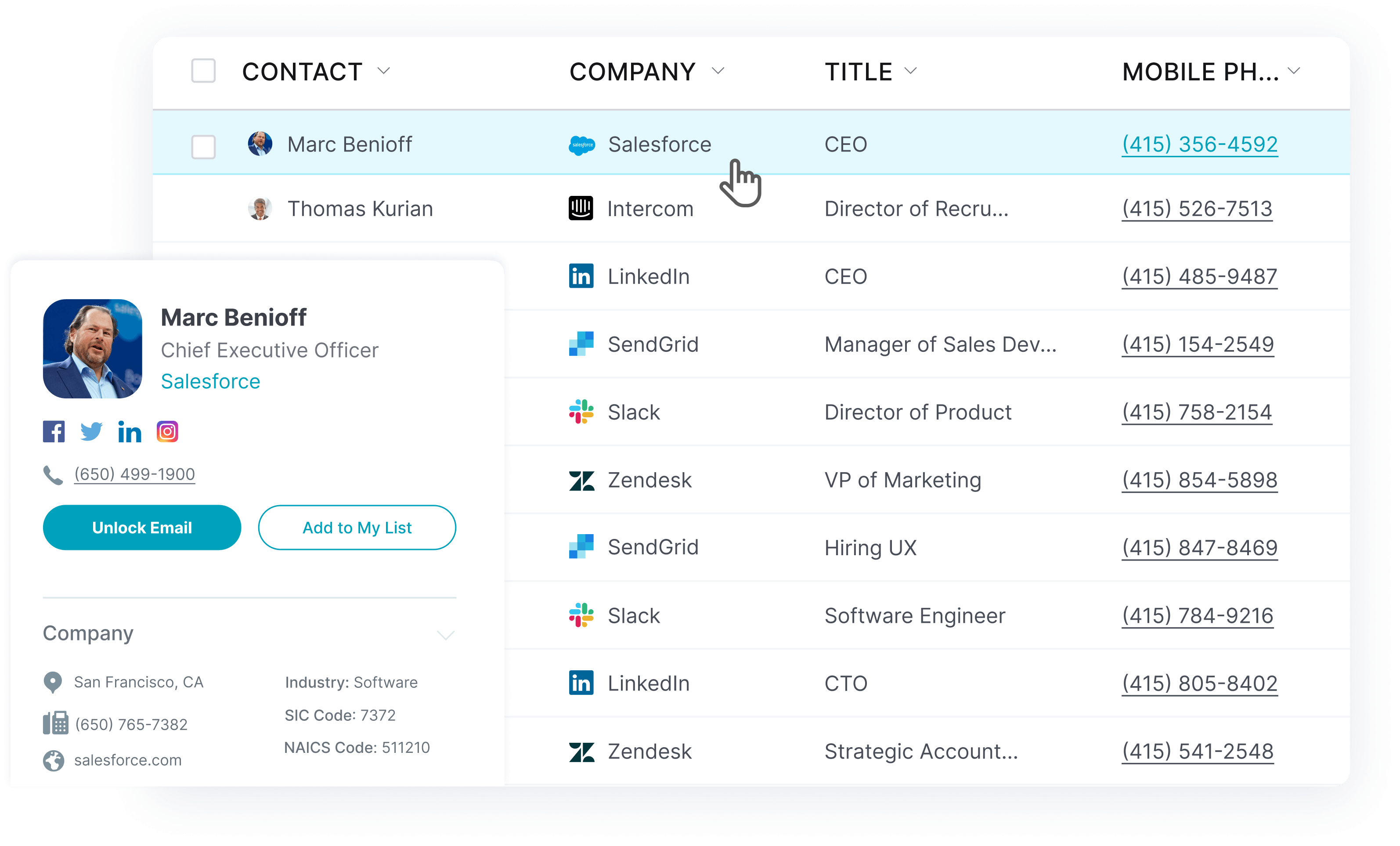In the high-stakes sales world, understanding the nuances of outreach is pivotal. For Sales Development Representatives (SDRs), striking the right balance in the number of calls made daily is a critical ingredient in the recipe for success. So, how many calls should an SDR make per day to achieve the best performance? Let’s analyze it.
📌 Important: It’s not just about making calls–it’s about making the right calls. High-quality leads can differentiate between a successful pitch and a missed opportunity. Let your SDRs use UpLead to call the right leads. Try UpLead and get 5 free credits!
Why Numbers are Crucial for Sales Teams
When your sales team dials a prospect’s number, they make a call and gather valuable data critical for driving success. In the realm of sales, numbers aren’t just digits; they are the pulse of your strategy, giving life and direction to your sales process. Every cold call, email, and follow-up is a thread in the intricate tapestry of your sales journey.
A study by The Bridge Group found that the average SDR makes 40 calls per day. This number isn’t arbitrary; it’s a calculated effort to optimize performance and yield results. It’s about quality as much as it is about quantity. Tracking these numbers ensures that your sales reps are not just busy but productive. It helps identify patterns, understand what works, and assess what needs improvement.
But it’s not just about making calls–it’s about making the right calls. High-quality leads can differentiate between a successful pitch and a missed opportunity. This difference is where the sales process intersects with data analytics. By keeping a close eye on relevant data and adhering to quality cold calling tips, such as the number of calls made, the duration of each call, and the conversion rate, your sales team can tailor their approach, focusing their efforts where they’re most likely to bear fruit.
How Many Calls Should an SDR Make Per Day?
So, how many calls should an SDR make per day? The straightforward answer is 40-50 calls. Let’s dive a bit deeper.
The role of an SDR is multifaceted; it’s not just about dialing numbers and making phone calls. An SDR establishes connections, understands the prospect’s pain points, and sets the stage for meaningful conversations. Therefore, while the quantity of calls is essential, the quality of these calls holds equal weight.
According to data from Gradient Works, outbound SDRs should aim for 40-50 calls per day, complemented by 10-40 personalized emails, totaling 80-100 activities per day. These goals are not just a random target; it’s a benchmark backed by extensive research and data analysis designed to optimize the sales development process and ensure every call counts. Additional data from The Bridge Group shows SDRs engage in 104 daily outreach activities, leading to 3.6 quality conversations.
These numbers are flexible. They serve as a guideline, a starting point. The actual number may vary depending on your industry, your target audience, and the unique dynamics of your company. The key is finding the sweet spot, where quantity meets quality; every call is a step towards achieving your sales goals.
Numbers to Consider Beyond Calls Made
While the number of dials you make in your outbound marketing efforts is undoubtedly significant in the intricate dance of sales development, it’s a mere tip of the iceberg. If your sales reps focus entirely on the “how many calls” aspect, they might neglect other significant metrics. Each of these metrics offers a fresh perspective on your team’s performance, and combined, they give you a holistic view of your sales pipeline.
Calls Accepted
Calls Accepted refers to the number of calls where the recipient, your potential lead, answers and engages in a conversation. Getting a lead to pick up the phone is the first barrier to going through your cold call list. It’s a tangible measure of your team’s reachability and can significantly affect the average number of conversions.
A low acceptance rate might hint at wrong call timings or an irrelevant prospect list. For your sales reps, it’s an opportunity to reassess and refine their approach.
Duration of Calls
Call Duration isn’t merely clocking time but how long a sales development representative can keep a prospect engaged. Longer durations often mean a prospect is interested, and your rep effectively navigates pain points and offers solutions.
If you’re experiencing short call durations, it might be time to revamp the pitch or invest in training. When your reps can maintain long conversations, it’s a testament to their skill – but if those lengthy calls aren’t converting? They might be spending too much time without getting to the point.
Conversion Rate
Your conversion rate is the percentage of calls that lead to a desired action, be it a quality meeting, a demo, or a sale. Conversion rates are the heartbeat of your sales efforts. It’s the most direct measure of a call’s success and offers a clear view of how effective the sales calls are.
A low conversion rate despite many calls can point to several issues – an unqualified leads list, a weak pitch, or a mismatch between what’s being offered and the prospect’s needs. Conversely, a high conversion rate with fewer calls indicates that the sales reps are likely tapping into high-quality leads and are adept at closing deals.
These metrics are essential to accurately picture your company’s sales performance. But remember, metrics are just numbers unless integrated into actionable strategies. You need to adjust your approach based on these metrics continually. After all, making calls is one thing; making them count is another.
By keeping an eye on these numbers and understanding what they signify, your business is better poised to refine its sales development strategies. Whether employing inside sales or outside sales techniques, ensuring each call your sales representatives make is purposeful is key. And as you dive deeper into the metrics, always keep in mind the ultimate goal: building genuine connections and driving conversions. Your prospects aren’t just numbers on a sheet but opportunities waiting to be transformed into valuable relationships.
Does the Day of the Week Matter for SDR Calls?
The day of the week can significantly impact the success rate of SDR calls, making it a crucial factor to consider when planning outreach strategies. Wednesday has been identified as the most effective day for making cold calls, as prospects are more likely to be settled into their work week and open to engaging in conversations. In addition, other studies have found that calls over five minutes typically occurred between 3 and 5 p.m. on Tuesdays and Thursdays. It’s important to take this data and your SDR call data to optimize for cold calling at the right time.
However, avoiding making calls on weekends is essential, as prospects are usually engaged in personal activities and less likely to respond positively to sales outreach. This time should be reserved for preparation and strategizing for the week ahead, including preparing scripts for upcoming conversations.
The target audience and industry also play a vital role in determining the optimal days and times for SDR calls. Different demographics and professional sectors may have varying preferences and availability, necessitating a tailored approach to call scheduling. By analyzing patterns and outcomes of past calls, SDRs can optimize their outreach efforts for maximum impact.
Setting & Measuring SDR Quotas
Setting realistic yet challenging quotas is crucial when managing your sales development representatives (SDRs). These quotas should be based on relevant data and numbers, ensuring your sales team has clear goals that drive them towards success. Using metrics like the number of calls made, calls accepted, call duration, and conversion rates can provide a comprehensive view of your team’s performance and help set accurate quotas.
Setting quotas isn’t just about deciding on a number of calls; it’s about understanding what each call means and what outcome it should lead to. Your SDRs shouldn’t just make calls; they should make connections, build relationships, and ultimately drive sales.
To measure quotas effectively, incorporate a blend of quantity and quality metrics. Track how many calls are made, how many are accepted, how long they last, and how many convert into meaningful interactions or sales. This way, you ensure your team is not just busy but productive.
UpLead Helps Make Every Call Count With Verified Leads
UpLead is a game-changer for SDRs, ensuring every call made is an opportunity, not just a task. Boasting a staggering 95% data accuracy rate, UpLead provides SDRs access to verified leads, drastically reducing time wasted on dead-end calls. Its user-friendly interface and over 50 search filters ensure that SDRs can quickly pinpoint their ideal prospects. Real-time email verification and robust Intent data further refine outreach efforts, while 16K+ technographic data points provide invaluable insights. With UpLead, SDRs and SDR Managers can confidently reach out, knowing they have the correct information at the right time.
Try UpLead for free today and instantly enhance your SDR call strategy.
Lead generation doesn’t have to be all that painful. With UpLead, you can easily connect with high-quality prospects and leads to grow your company.

FAQs About How Many Calls an SDR Should Make
Below are a few of the most frequently asked questions about how many calls an SDR should make.
An SDR’s primary goal is to book meetings that will eventually convert to sales. The sweet spot is about 12-15 quality monthly meetings, though this number can vary based on industry nuances and the complexity of the product or service being sold. The meetings booked must be with qualified leads, ensuring the time spent is productive and moving the sales process forward.
A balanced team is critical for optimal performance. A typical ratio observed in successful companies above $25 million in revenue is having one SDR for every four or five sales reps. This balance ensures that the sales team has a steady stream of leads to work on while maintaining a manageable workload for the SDRs. It’s a symbiotic relationship that, when balanced correctly, leads to increased productivity and sales.
Cold calling is a numbers game but also an art. According to cold calling studies, an SDR might need to make between 50 cold calls (2% cold call success rate) to make a connection with a decision-maker. Cold calling is still a valuable strategy. However, it’s crucial to note that the quality of the call, the preparation done beforehand, and the ability to connect and address the prospect’s needs are just as important as the quantity of calls made. Your cold call strategy is integral to your outbound sales efforts, so it’s important to hone your metrics in determining how many dials your sales team needs to make.
Managing accounts is a significant part of an SDR’s role. Ideally, an SDR should handle 150-200 accounts, striking the right balance between personalization and volume. This allows for enough diversity in outreach efforts while ensuring that each prospect receives the attention and tailored approach they deserve. In addition, the number of accounts decreases as the account size increases to adjust for the complexity of the sales environment. It’s about finding the right balance that makes SDRs effective and efficient in their outreach efforts.
What You Need to Remember About SDR Calls
Sales Development Representatives (SDRs) are critical in lead generation and customer engagement. The support provided to account executives is invaluable, and as a sales manager, it’s critical to Remember that it’s not just about quantity; the quality of each call matters. Balancing a high volume of sales calls with personalized, meaningful interactions will set the stage for successful relationships and, ultimately, sales conversions.
It’s not just about making calls–it’s about making the right calls. High-quality leads can differentiate between a successful pitch and a missed opportunity. Let your SDRs use UpLead to call the right leads. Try UpLead and get 5 free credits!









